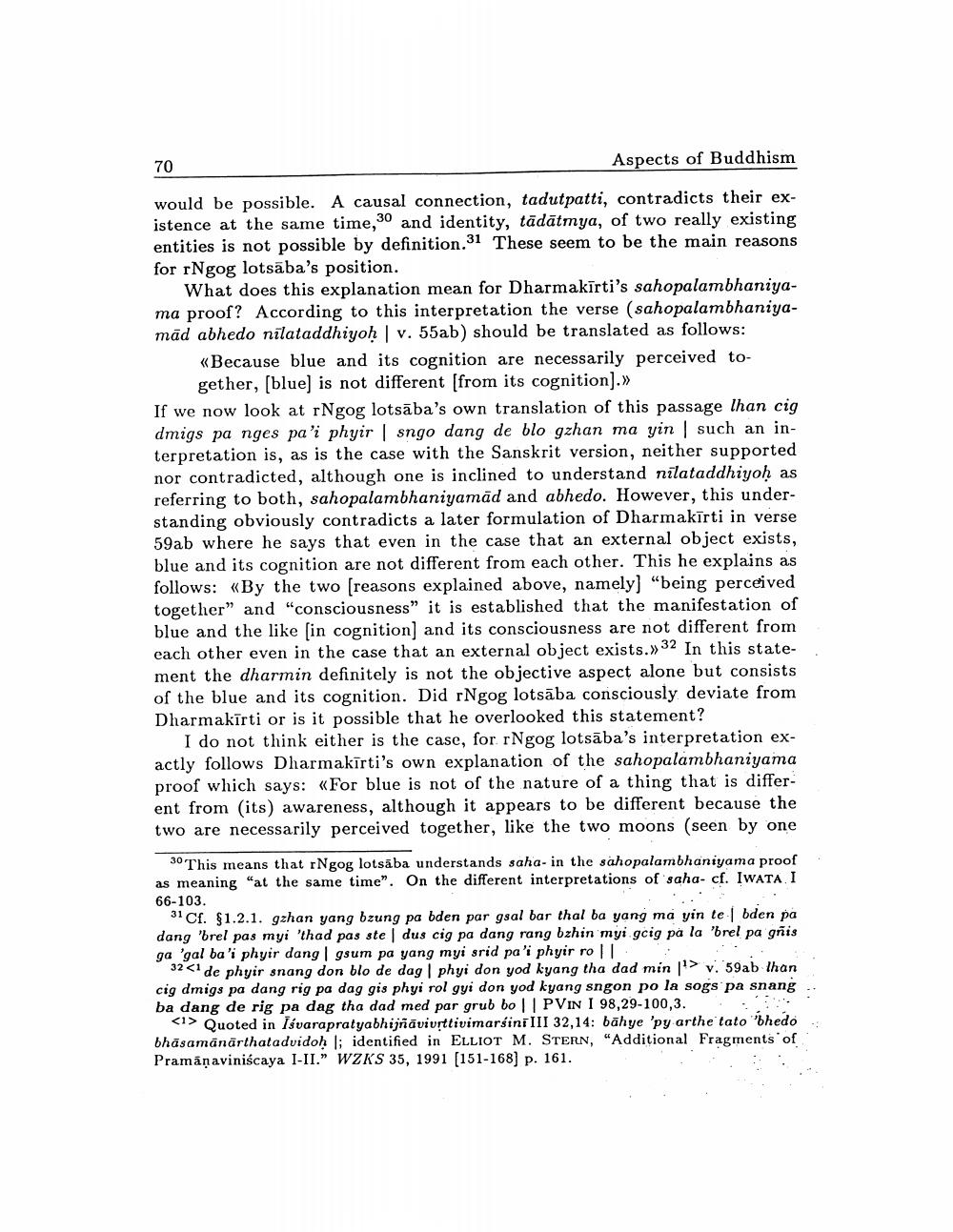Book Title: Rngog Lotsaba On Sahopalambhaniyama Proof In Dharmakirtis Pramanaviniscaya Author(s): Helmut Krasser Publisher: Helmut Krasser View full book textPage 8
________________ 70 Aspects of Buddhism would be possible. A causal connection, tadutpatti, contradicts their existence at the same time, 30 and identity, tādātmya, of two really existing entities is not possible by definition.31 These seem to be the main reasons for rNgog lotsāba's position. What does this explanation mean for Dharmakīrti's sahopalambhaniyama proof? According to this interpretation the verse (sahopalambhaniyamād abhedo nīlataddhiyoh | v. 55ab) should be translated as follows: «Because blue and its cognition are necessarily perceived to gether, (blue) is not different (from its cognition). >> If we now look at rNgog lotsāba's own translation of this passage lhan cig dmigs pa nges pa'i phyir | sngo dang de blo gzhan ma yin | such an interpretation is, as is the case with the Sanskrit version, neither supported nor contradicted, although one is inclined to understand nilataddhiyoḥ as referring to both, sahopalambhaniyamad and abhedo. However, this understanding obviously contradicts a later formulation of Dharmakīrti in verse 59ab where he says that even in the case that an external object exists, blue and its cognition are not different from each other. This he explains as follows: «By the two (reasons explained above, namely] "being perceived together" and "consciousness" it is established that the manifestation of blue and the like (in cognition) and its consciousness are not different from each other even in the case that an external object exists.>> 32 In this statement the dharmin definitely is not the objective aspect alone but consists of the blue and its cognition. Did rNgog lotsāba consciously deviate from Dharmakīrti or is it possible that he overlooked this statement? I do not think either is the case, for rNgog lotsāba's interpretation exactly follows Dharmakīrti's own explanation of the sahopalambhaniyama proof which says: «For blue is not of the nature of a thing that is different from its) awareness, although it appears to be different because the two are necessarily perceived together, like the two moons (seen by one 30 This means that rNgog lotsāba understands saha- in the sahopalambhaniyama proof as meaning "at the same time". On the different interpretations of saha- cf. IWATA I 66-103. 31 Cf. $1.2.1. gzhan yang bzung pa bden par gsal bar thal ba yang ma yin lebden pa dang 'brel pas myi 'thad pas ste dus cig pa dang rang bzhin myi gcig pa la 'brel pa gñis ga 'gal ba'i phyir dang 1 gsum pa yang myi srid pa'i phyir rol 32 < de phyir snang don blo de dag | phyi don yod kyang tha dad min "> v. 59ab than cig dmigs pa dang rig pa dag gis phyi rol gyi don yod kyang sngon po la sogs pa snang .. ba dang de rig pa dag tha dad med par grub bo || PVIN I 98,29-100,3. <i> Quoted in Isvarapratyabhijñāvivịttivimarsini III 32,14: bähye 'py arthe tato 'bhedo bhāsamānārthatadvidoh ); identified in ELLIOT M. STERN, "Additional Fragments of Pramāņaviniscaya I-II." WZKS 35, 1991 (151-168) p. 161.Page Navigation
1 ... 6 7 8 9 10 11 12 13 14 15 16 17 18 19 20 21 22 23 24 25 26
